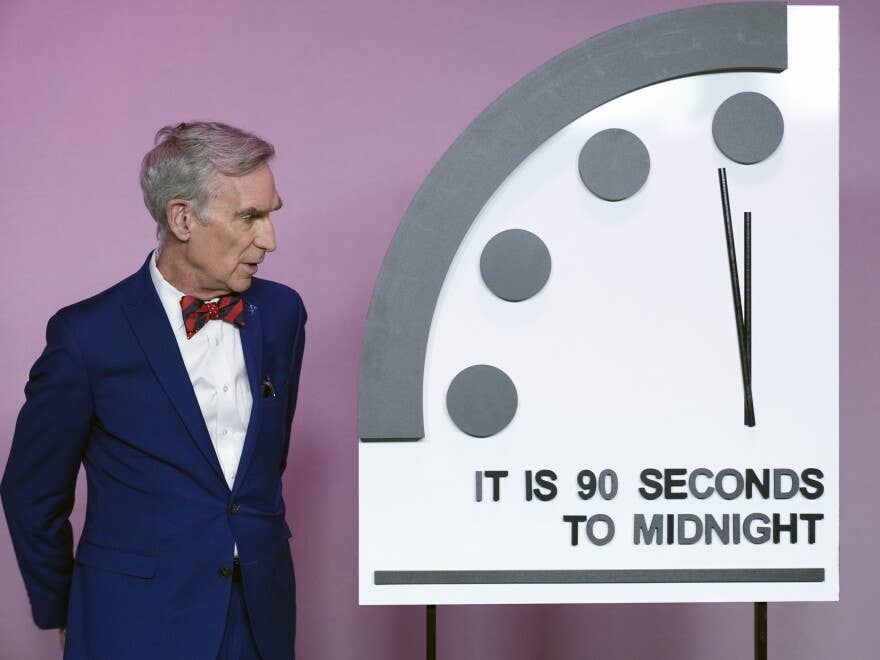Quantum computing used to create time crystals
Norman Yao first described five years ago how to make a time crystal—a new form of matter whose patterns repeat in time instead of space.

[Nov 9, 2021: Robert Sanders, UC Berkeley]
An artist’s impression of a discrete time crystal composed of nine qubits represented by the nuclear spins of nine carbon-13 atoms in diamond. The chain of connected spins is locked in a phase where they periodically invert their states. (Credit: Joe Randall and Tim Taminiau, courtesy of QuTech)
UC Berkeley physicist Norman Yao first described five years ago how to make a time crystal—a new form of matter whose patterns repeat in time instead of space. Unlike crystals of emerald or ruby, however, those time crystals existed for only a fraction of a second.
But the time has arrived for time crystals. Since Yao's original proposal, new insights have led to the discovery that time crystals come in many different forms, each stabilized by its own distinct mechanism.
Using new quantum computing architectures, several labs have come close to creating a many-body localized version of a time crystal, which uses disorder to keep periodically-driven quantum qubits in a continual state of subharmonic jiggling—the qubits oscillate, but only every other period of the drive.
In a paper published in the journal Science last week, Yao and colleagues at QuTech—a collaboration between Delft University of Technology and TNO, an independent research group in the Netherlands—reported the creation of a many-body localized discrete time crystal that lasted for about eight seconds, corresponding to 800 oscillation periods. They used a quantum computer based upon a diamond, where the qubits—quantum bits, the analog of binary bits in digital computers—are the nuclear spins of carbon-13 atoms embedded inside the diamond.
"While a perfectly isolated time crystal can, in principle, live forever, any real experimental implementation will decay due to interactions with the environment," said QuTech's Joe Randall. "Further extending the lifetime is the next frontier."
Related Stories
The results, first posted this summer on arXiv, were replicated in a near-simultaneous experiment by researchers from Google, Stanford and Princeton, using Google's superconducting quantum computer, Sycamore. That demonstration employed 20 qubits made of superconducting aluminum strips and lasted for about eight-tenths of a second. Both Google's and QuTech's time crystals are referred to as Floquet phases of matter, which are a type of non-equilibrium material.
"It is extremely exciting that multiple experimental breakthroughs are happening simultaneously," says Tim Taminiau, lead investigator at QuTech. "All these different platforms complement each other. The Google experiment uses two times more qubits; our time crystal lives about 10 times longer."
Qutech's team manipulated the nine carbon-13 qubits in just the right way to satisfy the criteria to form a many-body localized time crystal.
"A time crystal is perhaps the simplest example of a non-equilibrium phase of matter," said Yao, UC Berkeley associate professor of physics. "The QuTech system is perfectly poised to explore other out-of-equilibrium phenomena including, for example, Floquet topological phases."
These results follow on the heels of another time crystal sighting, also involving Yao's group, published in Science several months ago. There, researchers observed a so-called prethermal time crystal, where the subharmonic oscillations are stabilized via high-frequency driving. The experiments were performed in Monroe's lab at the University of Maryland using a one-dimensional chain of trapped atomic ions, the same system that observed the first signatures of time crystalline dynamics over five years ago. Interestingly, unlike the many-body localized time crystal, which represents an innately quantum Floquet phase, prethermal time crystals can exist as either quantum or classical phases of matter.
Many open questions remain. Are there practical applications for time crystals? Can dissipation help to extend a time crystal's lifetimes? And, more generally, how and when do driven quantum systems equilibrate? The reported results demonstrate that spin defects in solids are a flexible platform for experimentally studying these important open questions in statistical physics.
"The ability to isolate the spins from their environment while still being able to control their interactions offers an amazing opportunity to study how information is preserved or lost," said UC Berkeley graduate student Francisco Machado. "It will be fascinating to see what comes next."
For more science and technology news stories check out our New Innovations section at The Brighter Side of News.
Like these kind of feel good stories? Get the Brighter Side of News' newsletter.
Tags: #New_Innovations, #Quantum, #Time_Crystals, #Qubits, #Science, #Research, #The_Brighter_Side_of_News



